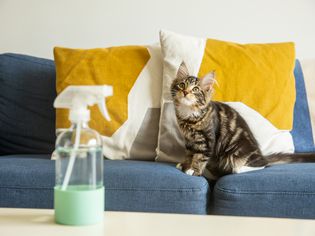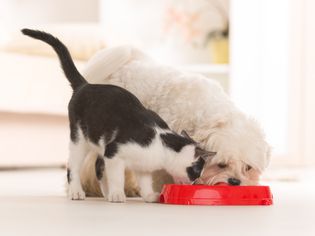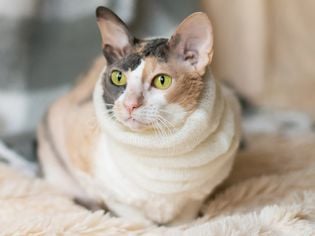Mums are popular Autumn plants beloved for their bright flowers, but they're not safe for cats. Mums, or chrysanthemums, contain substances that can cause harm if your cat eats them, and contact with mums can irritate your cat's skin.
Here's what every cat lover should know before displaying mums in or around their home.
Why Are Mums Toxic to Cats?
Mums contain chemical compounds that are toxic to cats, specifically pyrethrins and sesquiterpene lactones. These compounds work to protect the flower from insects and are sometimes used to create pesticides and bug repellants. However, cats are especially sensitive to these chemicals—eating mums or even coming into contact with the flowers can lead to toxicity.
Pyrethrins tend to irritate the gastrointestinal tract, but the real danger lies in the chemical's potential to harm the nervous system. Pyrethrins are used to create synthetic pyrethroids, longer acting synthetically modified compounds, which are used in flea and tick prevention products for dogs. Mums contain the natural form of pyrethrins, which are in a lower concentration and do not persist as long in the environment. Therefore, it would take a concentrated plant extract or a very large number of mums to be ingested before neurologic signs would be expected. Pyrethrin toxicity in cats is most common after the accidental use of dog pest control products. The toxic chemical is rapidly absorbed into a cat's body after ingestion or skin contact and may cause tremors or seizures.
Sesquiterpene lactones are known skin irritants found in various plants, including mums. Fortunately, simply brushing up against the plant is unlikely to cause problems since a cat's fur protects the skin. Cats are most likely to be exposed to this chemical in powdered mums, but direct skin contact with the flowers can technically cause a reaction.
Are All Types of Mums Toxic to Cats?
Mums are members of the genus Chrysanthemum and part of the Aster family (Asteraceae). There are about 40 species of chrysanthemum and over 100 varieties available from florists. These go by many names, including mum, chrysanth, daisy, pompon, and button. All types of chrysanthemums are considered toxic to cats, and the minimum toxic dose is unknown, so it's important to report exposure to your veterinarian promptly. In general, it's best to avoid bringing mums to your home so you can keep your cat safe.
Signs of Mum Poisoning in Cats
If your cat eats or comes into contact with any part of the chrysanthemum plant, you may notice signs within minutes to hours. Eating mums may cause gastrointestinal upset (most common) and central nervous system effects, which may become serious if left untreated. Skin contact can lead to dermatitis, which may look like an allergic skin reaction. Toxic effects range from mild to severe depending on the amount of toxin and the individual cat's sensitivity.
What To Do If Your Cat Eats a Mum
Contact your veterinarian if you suspect your cat has eaten part of a mum, even if you do not see any signs of illness. Record the time and amount eaten, if known. Your vet may advise you to come in right away or contact a poison service, such as ASPCA Poison Control or Pet Poison Helpline. If your cat is exposed to mums and your vet's office is closed, call an emergency veterinary facility or animal poison control for advice. Do not wait for symptoms to occur before taking action.
Warning
Never attempt to make your cat throw up without instructions from your vet, as this may cause more serious complications.
If your cat's skin has come into contact with a pyrethroid compound or mums, wash the area immediately with a gentle, cat-safe shampoo, and call your vet for further advice. If the chemical is on their fur, licking it may lead to excessive drooling and oral irritation in addition to the GI and neurologic risks. Your vet may need to treat the skin irritation with oral or topical medications and evaluate your cat for pyrethrin toxicity.
There is no antidote for pyrethrin toxicity in cats, so treatment will primarily consist of supportive care, including fluids and medications to ease pain, inflammation, and gastrointestinal distress. Cats with neurological signs may be treated with anti-convulsive medications or sedatives to control seizures or tremors.
How to Keep Your Cat Safe From Mums
The best way to protect your cat from mums is to keep them out of reach. If your cat stays indoors, you can safely keep mums in outdoor pots and gardens, but be sure to wash your hands after handling them. Avoid keeping mums on your property if your cat goes outdoors, but be aware that your curious kitty may be able to find the flowers on a neighbor's property. Make sure to use a proper feline approved product to protect your pet from parasites. Using dog products, even when splitting the dose can cause serious toxicity concerns.
Mums are out, but that doesn't mean you can't display plants and flowers in and around a home you share with cats. Consider these cat-safe houseplants, flowers, and garden plants:
- Areca palm
- African violet
- Boston Fern
- Bromeliad
- Cast iron plant
- Christmas cactus
- Gerbera daisy (unlike some other daisies)
- Hawthoria (a popular succulent)
- Orchid
- Spider plant










Comments on " Are Mums Toxic to Cats?" :